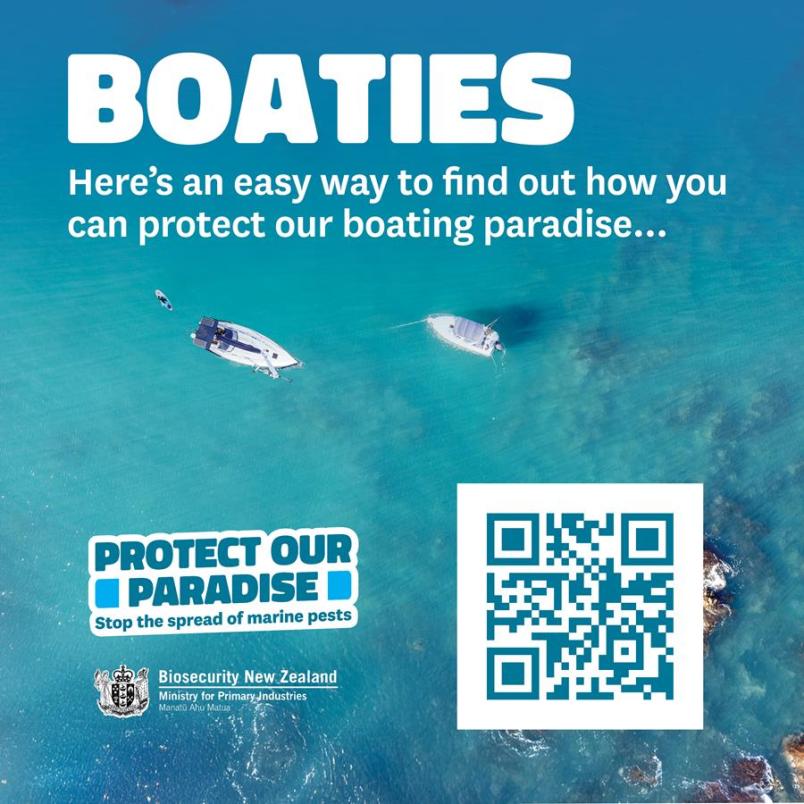Exotic caulerpa has been found at a new location near Kawau Island while restrictions have also been put in place over an area off Waiheke Island as the fight against the invasive seaweed ramps up for summer.
In its latest update, Biosecurity New Zealand confirmed that controls for the north coast of Waiheke Island will come into force at midnight tonight. This will set legal requirements for some fishing and boating activities in an area around Thompson’s Point and across Onetangi Bay where exotic caulerpa has been detected.
While people will still be able to anchor within the affected zone (see map below), equipment cleaning directions must be followed before leaving the controlled area.

Controlled area notices (CANs) are an important tool to help prevent the spread of exotic caulerpa, which can spread over long distances as small pieces, caught on anchors, anchor chains and other equipment including fishing and diving gear.
The law requires boaties to check their anchor, anchor chain and any equipment used in the water for attached seaweed or plant material. This includes, for example, diving and fishing gear, wetsuits and fins.
"Any seaweed found must be removed, bagged or securely contained, and taken ashore for disposal in a rubbish bin," Biosecurity New Zealand said in a statement.
"If secure containment isn’t possible, it can be put back into the waters it came from. The important thing is that it is not taken to other waters outside the controlled area. The equipment should be washed down with fresh or seawater and, where possible, left to dry before being used in another area.
"Launching vessels, including amphibious Sealegs-type craft is permitted, as is motoring or sailing through the waters of the controlled area."
The CAN also restricts some types of fishing activities that risk spreading caulerpa - including any method that makes contact with the seabed like netting, dredging, bottom trawling or potting.
Line fishing from the shore, drift fishing from a vessel, spearfishing and hand gathering, and shore-based longlining are all allowed.
The controls at Waiheke are not as restrictive as those for the Aotea and Te Rāwhiti CAN zones because the caulerpa is less dense at Waiheke, Biosecurity New Zealand said.
Tighter restrictions, including, potentially, a ban on anchoring, were initially considered. However, in a new development, a decline or reduction event has been confirmed at Waiheke. As a result, a less stringent CAN is now considered appropriate.
"Following multiple reports of a reduction in caulerpa cover at several locations in the Hauraki Gulf, we commissioned NIWA to determine the extent of this and the potential cause. Monitoring work was undertaken at Waiheke and at a number of locations at Aotea.
"NIWA's preliminary report shows that there have been large reductions in the cover of exotic caulerpa at some sites, notably in Onetangi Bay, Waiheke Island and Okupu Blind Bay at Aotea."

Exotic caulerpa has been discovered at a second location at Kawau Island in the Hauraki Gulf. Photos / NIWA
The biggest areas of decline have occurred in caulerpa on soft sediment or sandy seabed. However, it is still present in large amounts in rocky and intertidal areas and in deeper waters.
As well as Okupu and Waiheke Island, the team surveyed parts of Rangitawhiri/Tryphena Harbour and Schooner Bay at Aotea. These results were more variable with some declines in caulerpa cover but still significant amounts on rocky reefs and substrate.
"While this development is good news, we need to be cautious about interpreting it, and exotic caulerpa continues to present a significant challenge. We need more research to understand the significance of the decline and what has caused it," a Biosecurity New Zealand spokesperson said.
"Environmental factors and reproductive cycles could be involved, but the NIWA team believe varying water temperatures are not likely to be the cause as winter sea temperatures have not changed significantly in the three years since exotic caulerpa was detected here."
NIWA will be undertaking some surveillance work in Te Rāwhiti Inlet in the Bay of Islands to understand if any decline has also occurred there.
Meanwhile, the discovery of exotic caulerpa at a second location at Kawau Island in the Hauraki Gulf has been confirmed, with divers finding small, sparse patches distributed across a wide area in Bostaquet Bay on the south coast of the island.
NIWA divers examined six locations in the bay covering areas of seabed from 5-24 metres deep and across a range of substrates including sand, gravel, shell, reef and muddy sand.
Exotic caulerpa was confirmed in five out of those six locations, with an existing area of exotic caulerpa at Iris Shoal, to the northwest of the island.
Boaties are asked to, where possible, avoid anchoring and fishing in Bostaquet Bay.
Biosecurity New Zealand has published an interactive map of restricted areas that will be updated when required. You can find it here or by scanning the QR code below.
For more information on where exotic caulerpa has been found, what it looks like, CAN rules, and how you can help to stop the spread, click here.





